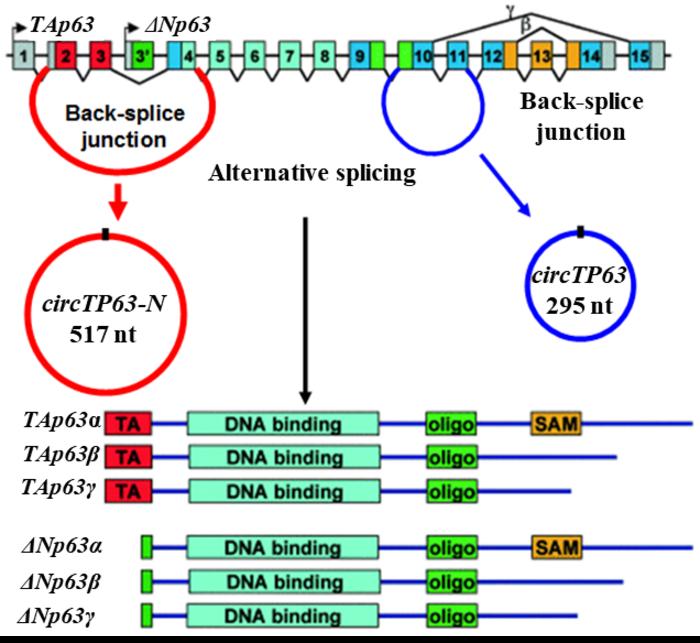
Nasopharyngeal carcinoma (NPC), a malignant tumor originating from the nasopharyngeal epithelium, presents distinct challenges due to its anatomical location and the nonspecific nature of its early symptoms. Most patients with NPC are diagnosed at advanced stages when lymph node metastases are already present, leading to a grim prognosis. One of the foremost complications in treating NPC is the frequent recurrence and metastasis, conditions that are intricately linked to aberrant gene expression patterns. Among these genetic alterations, the exact underlying mechanisms contributing to NPC pathogenesis remain largely enigmatic. Recent investigations, however, hint at the potential pivotal role of circular RNAs (circRNAs) in the progression and emergence of malignant tumors, yet their specific functions in NPC are just beginning to be elucidated.
A recent study published in Science China Life Sciences brought to light a novel circular RNA named circTP63-N that emerges during the splicing of the TP63 gene, noteworthy for its implications in NPC. The TP63 gene, an essential member of the TP53 family, is predominantly involved in cellular processes such as proliferation and differentiation. The study’s lead figures, Professors Zhaoyang Zeng and Can Guo, along with Researcher Wenjia Guo, spotlight the diminished levels of circTP63-N in clinical NPC samples, just as they underscore its substantial presence in healthy nasopharyngeal epithelium. Their findings indicated that restoring circTP63-N expression notably inhibits NPC cell proliferation and metastasis, stirring interest in its potential as a therapeutic target.
Delving deeper into the molecular landscape of the TP63 gene reveals its complex structure and varied splicing possibilities. This gene possesses two independent promoters: one situated upstream of exon 1, driving the transcription of TAp63, and the other located within intron 3, responsible for the transcription of ΔNp63. Collectively, these promoters give rise to distinct isoforms that undergo further processing to produce numerous variants, including α, β, and γ transcripts. While studies have identified other circular RNAs, such as circTP63, implicated in oncogenic processes, the exploration of circTP63-N’s role is unprecedented, marking a significant contribution to understanding NPC biology.
It is particularly intriguing that the research team noted a stark contrast between the expression levels of circTP63 and circTP63-N in NPC. Although circTP63 has been characterized in various malignancies as an oncomir, their analysis revealed that the expression of circTP63 was either greatly reduced or entirely absent in both NPC cell lines and biopsy specimens. Conversely, circTP63-N displayed a unique expression pattern, characterized by its abundance in non-cancerous nasopharyngeal tissues and significant downregulation in cancerous samples—a finding that could hold critical implications for diagnostic and therapeutic strategies.
In terms of functionality, the study meticulously demonstrated that circTP63-N interacts directly with HSP90AB1, a protein that has garnered attention for its involvement in several tumorigenic processes. By binding to HSP90AB1, circTP63-N facilitates the recruitment of LATS1/2 and YAP1 proteins. This recruitment orchestrates a cascade of molecular events leading to the phosphorylation and subsequent degradation of YAP1 through ubiquitin-mediated mechanisms. As YAP1 is pivotal for the transcriptional activation of genes associated with invasion and proliferation, including those related to the extracellular matrix and the cell cycle, the implications of circTP63-N in hindering NPC progression are profound.
The study’s innovative approach combined in vitro and in vivo experiments to validate the inhibitory effects of circTP63-N on NPC cells. Results revealed that enforced expression of this circular RNA not only curtailed the proliferation of NPC cells but also effectively diminished their invasive and migratory capabilities. Such insights not only augment our understanding of the regulatory networks governed by the TP63 gene but also emphasize circTP63-N as a novel player with significant regulatory potential in cancer biology.
Furthermore, the authors acknowledged the contribution of various collaborators in the study, including Professors Guiyuan Li, Wei Xiong, and Bo Xiang. Their collective efforts highlight the importance of interdisciplinary research in unraveling the complexities of cancer biology, particularly in niche areas such as circRNA function and gene regulation. The study presents promising avenues for research into therapeutic interventions that could potentially augment the current arsenal against NPC.
Emerging research into circRNA such as circTP63-N may reshape therapeutic strategies for malignancies like NPC. As the understanding of these molecules deepens, it opens the door for innovative treatments that leverage the unique properties of circRNAs to modulate tumor behavior. The potential for circRNAs to act as biomarkers for diagnosis or therapeutic targets can revolutionize traditional approaches to cancer treatment.
The implications of this research resonate beyond nasopharyngeal carcinoma, as they touch upon larger themes within cancer biology relating to gene regulation and the multifaceted roles of non-coding RNAs. As the landscape of cancer research continues to evolve, studies like this pave the way for breakthroughs that could lead to more effective, targeted treatment options and improve patient outcomes for those battling malignancies.
In conclusion, the recent study exploring circTP63-N’s role in nasopharyngeal carcinoma sheds light on new molecular mechanisms underlying tumor behavior. While much is yet to be uncovered, the initial findings pave the way for future explorations that could not only provide clarity regarding NPC but also enhance our understanding of circular RNAs in cancer and their therapeutic potential. The spotlight on circTP63-N underlines the importance of ongoing research endeavors aimed at unlocking the complex dance between genes, their transcripts, and their roles in cancer.
Subject of Research: Nasopharyngeal carcinoma and circular RNA
Article Title: CircTP63-N suppresses the proliferation and metastasis of nasopharyngeal carcinoma via engaging with HSP90AB1 to modulate the YAP1/Hippo signaling pathway
News Publication Date: October 2023
Web References: 10.1007/s11427-023-2737-2
References: Science China Life Sciences, October 2023
Image Credits: ©Science China Press
Keywords: Nasopharyngeal carcinoma, circular RNA, circTP63-N, TP63 gene, HSP90AB1, YAP1, Hippo signaling pathway, tumor biology, cancer research.
Tags: advanced stage cancer diagnosiscancer metastasis mechanismscircTP63-Ncircular RNAs in cancergene expression patterns in NPCHSP90AB1 interactionmalignant tumor progressionnasopharyngeal carcinoma researchrecurrence of nasopharyngeal carcinomaTP63 gene role in NPCtumor growth inhibitionYAP1 Hippo signaling pathway





